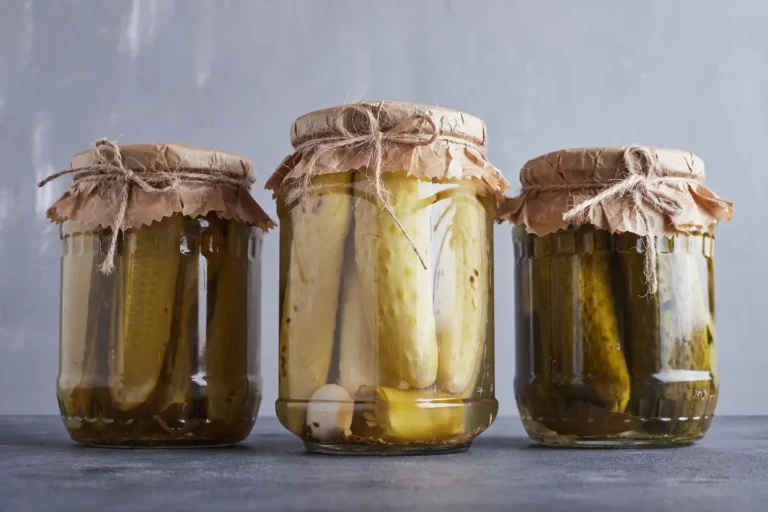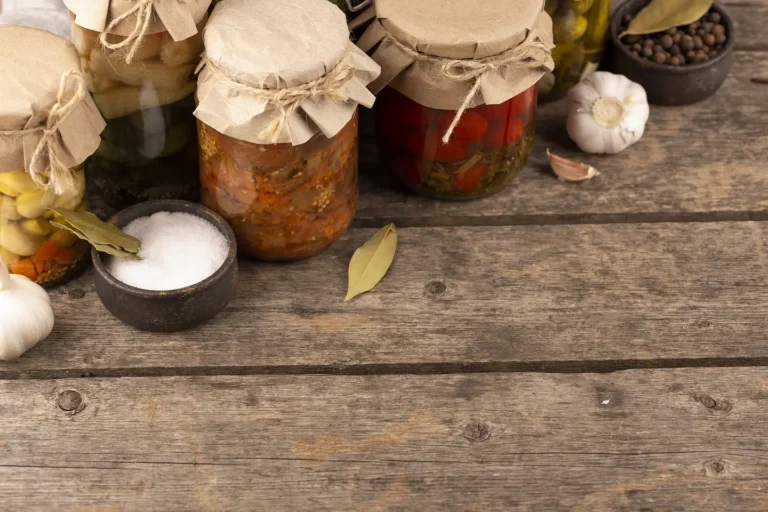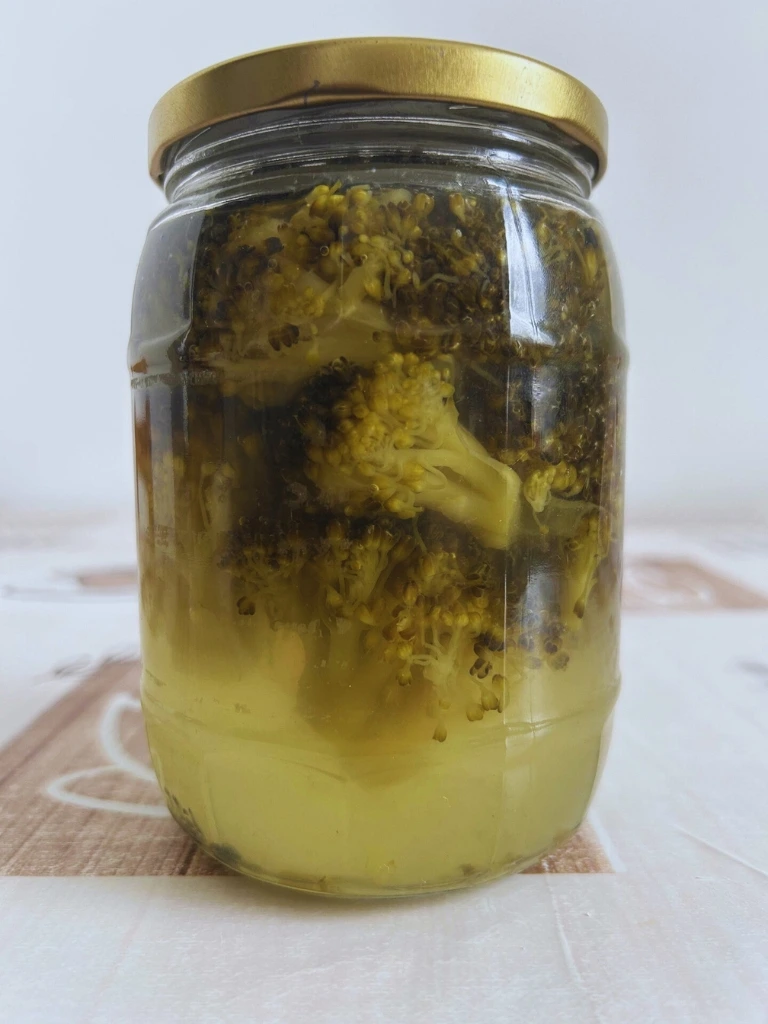Lactic Acid Fermentation: Understanding the Science, Seasonings, and Salt Usage
Lactic acid bacteria characteristically derive their energy from the enzymatic breakdown of carbohydrates, which is how they “feed.” Through the transformation of carbohydrates, they produce various organic acids, bioactive substances, and in certain cases, carbon dioxide. Compared to undesirable competitors (those causing spoilage or disease), they are highly salt- and acid-tolerant, and thrive excellently in oxygen-poor environments, allowing them to easily and quickly displace competitors under appropriate conditions. They feel best at temperatures above 18°C (especially around 35-42°C) – the warmer it is, the more vigorously they work and reproduce. At least for a while.
Their natural habitat includes soil, tubers, the surface of vegetables and fruits, and the human body (including the skin on our palms). To cultivate them and create delicious, fermented pickled foods with their help, we don’t need any special ingredients.
What Can Be Fermented
Through lactic acid fermentation, we can preserve or pickle any plant that can be safely consumed raw. Raw materials requiring heat treatment can be fermented after proper preparation and controlled inoculation (meaning inoculated with a starter). In this chapter, I’ve collected practices related to vegetables and fruits, but we’ll return to lacto-fermentation later in connection with legumes, grains, and plant milk alternatives.
Seasonal Considerations
It’s best to ferment all vegetables and fruits during their own season, picked directly from the field. Naturally, this isn’t possible throughout the year – in such cases, it’s worth thinking ahead and working in advance. Our pickled foods can last until the next season if we preserve them at the right time and with the right method. Due to high daily average temperatures, from spring to late summer, it’s better to prepare pickled foods for immediate consumption or shorter-term storage. The real pickling season runs from September to November – though for cucumbers and zucchini, the start can be moved up a few weeks earlier. During this time, it’s good to prepare larger quantities of everything so there are enough reserves for winter.
Winter Challenges
During this part of the year (mainly from mid-January to the end of March), except for sprouts and dried goods, no plants are in season. Autumn vegetables have already lost most of their moisture and nutrient content during months of storage by this time. Neither this nor the persistently low or fluctuating outdoor temperatures favor lactic acid bacteria, so during these tight three months, we may encounter many difficulties if we want to prepare fresh, fermented pickled foods.
Of course, we can work with frozen or canned goods at any time, but with a few exceptions, these will never be as delicious as ferments made from fresh ingredients. Let’s pay attention to one thing when working with such ingredients: they should not contain oil or sugar by any chance! Sugar can push the fermentation in an alcoholic direction or make it too vigorous, while oil provides an excellent breeding ground for pathogenic microorganisms (such as the bacteria responsible for botulism).
Combining Ingredients
If we’re just getting acquainted with lacto-fermentation, let’s start with something simple and familiar: cucumber or cabbage.
For the first time, it’s worth trying other vegetables alone, without any seasoning. This way we can taste what flavor each plant will have under the influence of lactic acid fermentation.
When combining several different vegetables, let’s pay attention to always choosing from those of similar firmness – especially if we’re pickling with brine. For example, it’s worth fermenting cucumber with zucchini, cauliflower with cabbage or carrot (I’ve suggested appropriate pairings for each ingredient among the recipes). Generally, combinations made from vegetables that ripen simultaneously work best.
Fermentation Speed Differences
Sweeter ingredients richer in simple sugars and prebiotics – sweet potato, Jerusalem artichoke, pumpkin – ferment more vigorously, while vegetables containing complex carbohydrates (such as starch) – beets, carrots – ferment more slowly and for longer periods. It may be worth combining these with each other and preparing them together, grated or shaved to the same size, salted dry.
Seasonings and Fermentation Inhibitors
When seasoning pickled foods, I would also recommend starting simply with well-tried flavors (ones we like). Let’s use classic pickle spices in various combinations: dill, garlic, pepper, mustard seed, coriander, bay leaf, juniper berry, chili. At the end of simpler base recipes, I’ve also collected more special spice tips. Those who like the flavors of exotic cuisines can confidently try the most characteristic spice blends!
When experimenting with new recipes, let’s simply listen to our instincts and senses. I usually choose spices by leaning over the chopped vegetables and waving the spice jar in front of my nose a few times. If the two scents are harmonious, it creates a clearly pleasant sensation.
Spice Quantities and Effects
The quantities in the book are only guidelines and result in adequately spicy but not excessive flavor. We can confidently use less or more of everything, but it’s important to know that there’s a spice quantity that can significantly slow down or even prevent fermentation. The reason is that the aromatic compounds of aromatic spice plants are without exception antibacterial. Besides their fine flavor, their additional advantage is that alongside the brine concentration, we can use them for further regulation of fermentation and to keep easily softening vegetables (zucchini, cucumber, cabbage) crispy. High-tannin grape and sour cherry leaves, horseradish root and leaves, and onion family plants in large quantities can also help us with this. However surprising, potatoes often recommended in sourdough cucumber recipes without bread also have antimicrobial effects due to the aspartyl proteases they contain. Plants rich in polyphenols and flavonoids (citrus fruits, sage family, oregano, thyme, cinnamon, etc.) have similar effects.
Natural Coloring Agents
Unfortunately, it’s impossible to preserve the beautiful bright green color of vegetables during lacto-fermentation. While various freeze-dried, powdered greens (spinach, matcha, parsley, alfalfa, spirulina, broccoli, wheatgrass) are excellent for coloring sourdough doughs or plant milk alternatives, we won’t find much use for them in pickling: the chlorophyll responsible for green color breaks down under the influence of bacterial enzymes, fades, and becomes yellowish or brownish.
Color Options
This isn’t the case with turmeric’s bright sun-yellow pigments. The curcumin that gives the rhizome its color becomes increasingly vivid in acidic environments, sometimes even neon-colored, making our duller ferments fantastically spectacular.
Orange shades (from ocher yellow to brick red) can most easily be achieved with various paprikas, saffron, or safflower. Korean kimchi paprika (gochugaru) has a legendarily bright red color that also dissolves well – unlike Cayenne pepper, for example.
The coloring agent in beets is betalain, which is slightly pH-dependent; in sourdough doughs and less acidic products like plant milk, it gives purple, burgundy, and crimson shades, while in pickled foods and acidic brines, it colors burgundy and red.
pH-Dependent Colors
Berry fruits, purple cabbage, purple sweet potato, and the currently very popular blue butterfly pea flower all get their color from anthocyanin. This pigment is very strongly pH-dependent and is often used as an indicator. In strongly alkaline environments, it can be green or even yellow; in neutral environments (such as doughs), blue or bluish-purple; in acidic environments, pinkish-purple, crimson. Thanks to this property, we can excellently follow the decrease in our pickled food’s pH during lactic acid fermentation: when, for example, the salty brine around purple cabbage changes from bluish-purple to crimson, we can be sure we’re on the right track.
Only the blue spirulina pigment, phycocyanin, remains blue in acidic environments. Small amounts can be extracted from green spirulina powder through “chromatography”: dissolve green spirulina powder in a little water, then strain through a coffee filter to get the blue-colored particles.
Water Quality
Let’s not forget that the chlorine in tap water has antibacterial effects (that’s exactly why it’s there). So let’s start every recipe requiring salty or sweet brine with dechlorinating the water. We have several options for this.
If we have any water purification equipment at home (such as a faucet-mounted device or a filter pitcher), it’s simplest to use that. If not, we’ll need a larger pot. Fill it with a bit more water than the desired amount, then boil and wait until it cools to room temperature. Without boiling, we can also promote the evaporation of dissolved chlorine gas by pouring into a wide container and stirring occasionally, but this goes much slower, taking days.
Alternative Water Sources
If we use spring water, it’s worth boiling that too due to possible contamination at the collection site. The higher dissolved mineral content of various mineral waters (such as iron-rich medicinal waters) can help preserve vegetable crispness, but in certain cases (such as sulfur- or iodine-containing mineral waters), they can even have unfavorable effects on microorganisms. If we use such water, let’s always test it: first prepare only a smaller batch to see the results. For our own health, let’s regularly alternate between different types of mineral water.
If we’re fortunate enough to live where we have access to salty spring water or clean seawater, we can try these after boiling too. Let’s look for reliable information about their concentration or get a refractometer to roughly measure the water’s salt content. Seawater is generally 3.1-3.7% concentration, while salt spring water has very variable composition (see the significance of this in the next section).
Salt Selection and Usage
Salt plays a particularly important role in directing spontaneous fermentation. It extracts water and some dissolved cellular components from the raw materials’ tissues, making them much more accessible to microorganisms. Additionally, properly dosed salt has a selective inhibitory effect on certain bacteria, fungi, and pathogens, thus promoting the proliferation of salt-tolerant species – such as lactic acid bacteria. The lactic acid they produce can effectively lower the pH of pickling vegetables, increasingly protecting them from spoilage.
Above 10% concentration, salt prevents microorganism reproduction and thus the start of the entire fermentation process – but this is already a different preservation method.
Salt Types
For fermentation, let’s use natural salt free of iodine and additives. This can be sea salt (such as Italian, Greek, Maldon, or Celtic salt) or mined salt (such as Parajd, Austrian, or Himalayan salt), but it’s best to choose the least processed, least refined form. Let’s treat specialty salts (smoked salt, black salt) more as spices, using them not directly for fermentation but for flavoring sandwich spreads and sauces, and salt flowers and flakes for garnishing our dishes.
How Much, When, and How to Use Salt
We can add salt to the raw material we want to ferment in two ways: in the form of pre-prepared brine or mixed dry with the vegetables. Which technique we use depends mainly on the season, raw material, and chopping method. Naturally, if obtaining abundant pickle juice is specifically one of our goals, we can add mildly salty (1%) brine to dry-salted pickled foods too.
When using brine, we pour the pre-mixed salt solution over the vegetables – this way there will ultimately be about half the total salt content in the jar compared to preparing the same amount with dry salting. Generally speaking: 2% dry salting roughly corresponds to using 4% brine.
Salt Concentration Guidelines
Fortunately, in our climate and with our microbiological conditions, this lower salt concentration is also workable (naturally strictly observing airtight sealing and ripening at room temperature) – in fact, it better suits average Hungarian taste. As we’ll see in the recipes, I only deviate from using 2% brine in very exceptional cases. If someone prefers it saltier, they can confidently increase the concentration.
Health Considerations
Daily Salt Intake
The World Health Organization (WHO) recommended maximum daily salt intake for adults is 5g (unfortunately regardless of gender, exact age, or health status – this wouldn’t be irrelevant). According to the last research I read, an average Hungarian adult can consume as much as 15-20g of salt per day.
If someone regularly consumes fermented vegetables and their juice in large quantities, they should include its salt content in their total daily salt consumption, according to the following: a 720ml jar’s filling weight is about 300-400g for chopped vegetables, plus 300-400ml brine, which contains about 6g salt at 2% concentration. Some of the brine exchanges with the cucumber’s own intercellular fluid, and about half its salt content enters the cucumber; as a result, the juice will have about 0.9% salt content (= about 2.7g salt), while the rest goes into the cucumber (= about 3.3g salt). For other raw materials, these numbers may vary somewhat, but the process is similar: nearly half the salt content of the brine going into the jar ends up in the vegetables, while the other half ends up in the juice.
Dry Salting vs. Brine Method
With dry salting, roughly 800g of kneaded, well-compressed dry material fits into a same-sized (720ml) canning jar. Prepared with 2% salting, this results in much higher salt content of 16g per jar.
Therefore: consuming one 720ml canning jar of pickled food made with brine, vegetables and juice together, uses up the WHO-recommended daily salt intake maximum, while with dry salting, one-quarter to one-third of a (720ml) canning jar, or 250g by weight. Let’s proportion this to our own consumption (and seasoning) habits!







